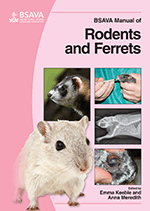
Full text loading...

Anatomical and physiological features important for anaesthesia and surgery in the ferret are not that different from those of more common pets like dogs and cats. Surgical instruments for ferrets include those most commonly used in general surgery for dogs and cats, but their size has to be smaller. Diagnostic surgical procedures such as exploratory laparotomy and biopsy of abdominal organs are detailed. The chapter also looks into the General principles of surgery; Effective surgical procedures; Therapeutic surgical procedures; Basics of orthopaedics and fracture repair; and Miscellaneous procedures.
Ferrets: common surgical procedures, Page 1 of 1
< Previous page | Next page > /docserver/preview/fulltext/10.22233/9781905319565/9781905319565.23-1.gif

Full text loading...

























